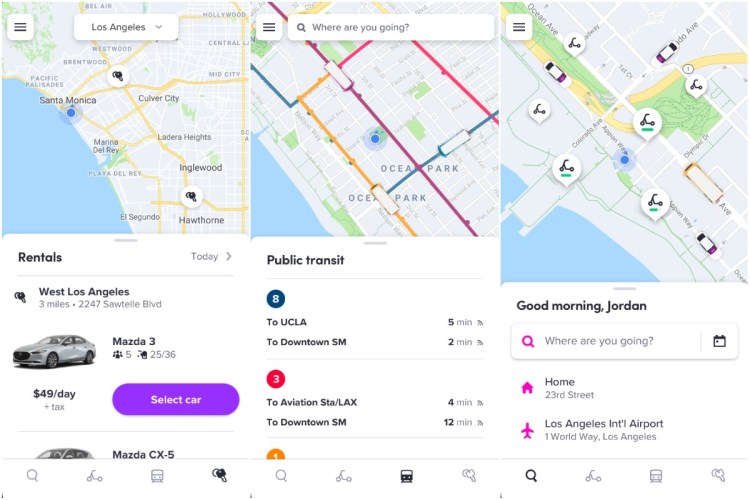Lyft continues to forge ahead in its effort to become a one-stop transportation hub. A week after the company added protected scooter- and bike-friendly routes to its mobile app, it today took the wraps off a revamped experience that spotlights bike, shared ride, scooter, subway, bus, and walking options in cities around the U.S.
Once it rolls out to Android and iOS devices over the course of the next few weeks, Lyft users will see an expanded list of transportation methods (along with associated prices and travel times) when they type in a destination. It’ll be joined by a multimodal map displaying a real-time view of nearby scooters, public transportation, and more, and a transit tab that’ll bubble to the top bus, train, and subway arrival times.
As for rental car customers, those in Los Angeles and San Francisco can now access daily car rentals as part of a pilot program. Lyft will offer $20 in credit to transport drivers to and from the rental lot. (It’s worth noting it’s separate and distinct from Express Drive, Lyft’s program that facilitates car rentals with partners like Avis Budget Group, Flexdrive, and Hertz.)
Lyft made the new screens, maps, and integrations available last December in select cities including Washington, D.C., Santa Monica, and Los Angeles, but this marks the general availability of those features.
June 5th: The AI Audit in NYC
Join us next week in NYC to engage with top executive leaders, delving into strategies for auditing AI models to ensure fairness, optimal performance, and ethical compliance across diverse organizations. Secure your attendance for this exclusive invite-only event.
“At Lyft, we’re working toward a future where cities are centered around people, not cars,” said Lyft cofounder and president John Zimmer. “The changes we’re making today will unlock better transportation solutions — whether that’s a trip on public transit, a bike ride or a shared Lyft — for people in cities around the country.”
Lyft outlined its multimodal strategy back in July, with the ambitious goal of taking 1 million cars off the road by 2019. The ride-hailing company hopes to increase the percentage of shared rides taken by 50% (it’s at a third today), and to encourage car-free trips by investing in programs to bring transport access to underserved communities and by offering discounts on rides that start or end near transit stops.
To this end, Lyft dipped its toes in the electric scooter market back in September 2018, with the rollout of a pilot service in Denver, Colorado. In December, it brought additional scooter fleets to Arlington County (Virginia), Atlanta, Austin, Los Angeles, Nashville, San Diego, Santa Monica, and Washington, D.C., preceding the debut of a Segway-made pink-wheeled scooter that can hold a charge for 35 to 40 miles.
As for Lyft’s bike-sharing business, its catalyst was the company’s roughly $250 million November 2018 purchase of Motivate, an operator of sponsored bike-sharing programs in metros like Chicago, San Francisco, Oakland, New York City, Washington D.C., and Portland. That same month, Lyft revealed it would invest over $100 million in Motivate’s Citi Bike over the next five years, more than tripling the number of available bikes in New York City alone. And in June, Lyft relaunched Ford GoBike — the Bay Area docked bicycle-sharing company Ford kicked off in partnership with Motivate — as Bay Wheels, with new electric bikes sporting pedal assist and stronger antitheft locks.
Prior to the Lyft acquisition, Motivate operated eight bike-share systems across the U.S., 12,000 of which were concentrated in New York. Lyft previously said it expects to bolster the Citi Bike fleet alone by 28,000 bikes, and to up the number of its docked and dockless bikes in the Bay Area to 8,500.


